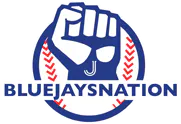Back in the win column 😃 #lightsupletsgo FINAL: Blue Jays 8, Angels 5
Yariel Rodriguez is a perfect example of how all relievers must be ready for high leverage in the modern game

Photo credit: © Jordan Godfree - USA Today
May 9, 2025, 16:00 EDTUpdated: May 9, 2025, 15:00 EDT
As Chris Bassitt left Thursday’s game against the Los Angeles Angels after six innings of four-run ball, a drained Toronto Blue Jays bullpen turned to Yariel Rodriguez to hold their 7-4 lead.
A starter for the Blue Jays in 2024, Rodriguez has had to adjust to coming out of the bullpen this season. There were arguments from both sides of the fence about what to do with him at the start of the year and whether he should be a long reliever or a late-game, high-leverage arm.
It turns out that if you said both, you ended up being correct. Rodriguez pitched an excellent two innings, allowing only one unearned run to set up Chad Green for the save in the ninth, as the Jays won 8-5.
The way baseball has evolved as a sport has seen fewer and fewer specific roles out of the bullpen. Most teams don’t have a designated mop-up pitcher, a designated middle relief guy, some go as far as ditching designated set-up men. Look at the Cleveland Guardians, who have numerous pitchers to take care of high-leverage spots such as Emmanuel Clase, Cade Smith, Hunter Gaddis, Paul Sewald, Tim Herrin, and the list goes on.
Aside from left-handed specialists and closers, all of those other roles have been blurred together into one big amalgamation of solid, flame-throwing arms that can induce swing-and-miss in any situation. That may be attributed to the three-batter minimum rule that came into effect some time ago, or teams are just looking to maximize the space they have down in the bullpen. Maybe a combination of both or some other factors.
Another big reason can also likely be attributed to starting pitchers not operating like they used to. While Bassitt had a respectable start on Thursday and Rodriguez was filling in for a worn-down pitching staff, oftentimes, pitchers are going less than six innings during their starts.
Whether that is because of increased velocity causing more strikeouts and in turn higher pitch counts, hitters constantly improving and adapting and drawing out pitch counts, or another reason altogether is for you to decide. Regardless, shorter starts require teams to have deeper bullpens. If a starter is leaving in a tie game in the fourth or fifth inning, a manager can’t put in a throwaway pitcher, he has to lean on a high-leverage hurler.
Yariel Rodríguez has looked the best he has all season in these last 2 outings. 3.1 IP, 2 H, 0 R, 0 BB & 7 K Most importantly, he's attacked the strike zone (43 pitches, 32 strikes). #BlueJays
Diving deeper into the Jays’ pen, almost all of their relievers are capable of throwing 95 mph or higher fastballs (think Jeff Hoffman, Yimi Garcia, Green, and Rodriguez). Those that don’t consistently, such as Nick Sandlin or Mason Fluharty, have nasty breaking pitches and both rank 75th percentile or higher in whiff%.
To be a reliever in the current state of MLB, you have to either have great velocity or a wipeout pitch. You also need to be able to go more than one inning if needed, like Rodriguez did on Thursday.
It’s a lesson to all players trying to climb the ranks to the big leagues. Whether they’re in the minor leagues, college ranks, or even high school players, they can’t pigeon-hole themselves into a single role. Relievers are now asked to fill a variety of roles based on what the team needs on a given day.
As protective measures such as shorter starts continue to be introduced to protect arms across the league, relievers will more consistently be asked to pitch two or more innings in close games. Whether that’s a good or a bad thing is for you to decide.
Celebrate Vladdy’s big news in style with the exclusive new BlueJaysNation Vladdy merch — available only at NationGear.ca! Rep a future Hall of Famer and wear your team’s pride loud. Limited drop. Don’t miss out.
Breaking News
- Blue Jays: Examining the financials on a potential Bo Bichette contract
- Report: Japanese right-hander Tatsuya Imai signs three-year deal with the Houston Astros
- Looking at Myles Straw’s future with the Toronto Blue Jays
- Report: Josh Winckowski returns to Blue Jays on two-year, minor-league deal
- Giants ink Tyler Mahle to one-year deal

